Vietnamese consumers’ preferences for traceable food and safety attributes: The case of water spinach
The government struggles to fight escalating food safety issues in
Vietnam. However, government measures yielded little evidence of
improvement to domestic food safety. For that reason, consumers
lower their trust in the government. The current market context, and
low trust towards the government left consumers to count on their own
judgement for the sake of their own food safety. This study applied
choice experiment method based on Lancastrian consumer theory and
random utility theory to elicit consumers’ preferences on traceable safe
foods and the perception regarding food safety. The impact of food
safety related attributes was identified in the order of decreasing
magnitude: Freshness, label, traceability, certification, and price.
Results suggested that Vietnamese consumers adhered food quality to
food appearance (i.e. freshness) and made judgement with such
perception. This paper also highlighted a noticeable reverse impact of
the level of food certification on consumer preferences toward safe
choices, which contributed to the current food safety situation in
Vietnam. The reason was expected to be trust issues in the
government, the impact of food safety context, and consumers’ false
perception of food safety.
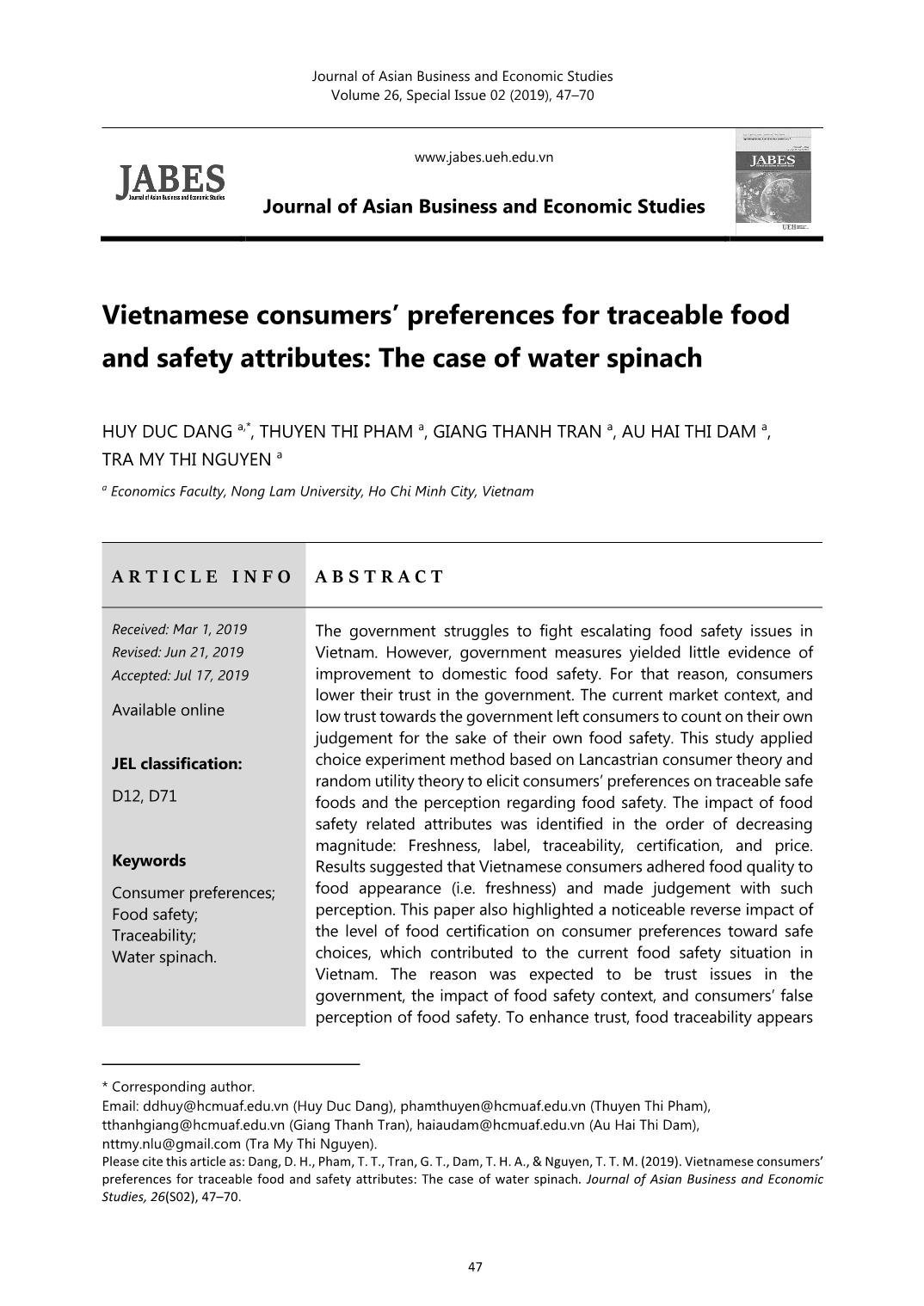
Trang 1
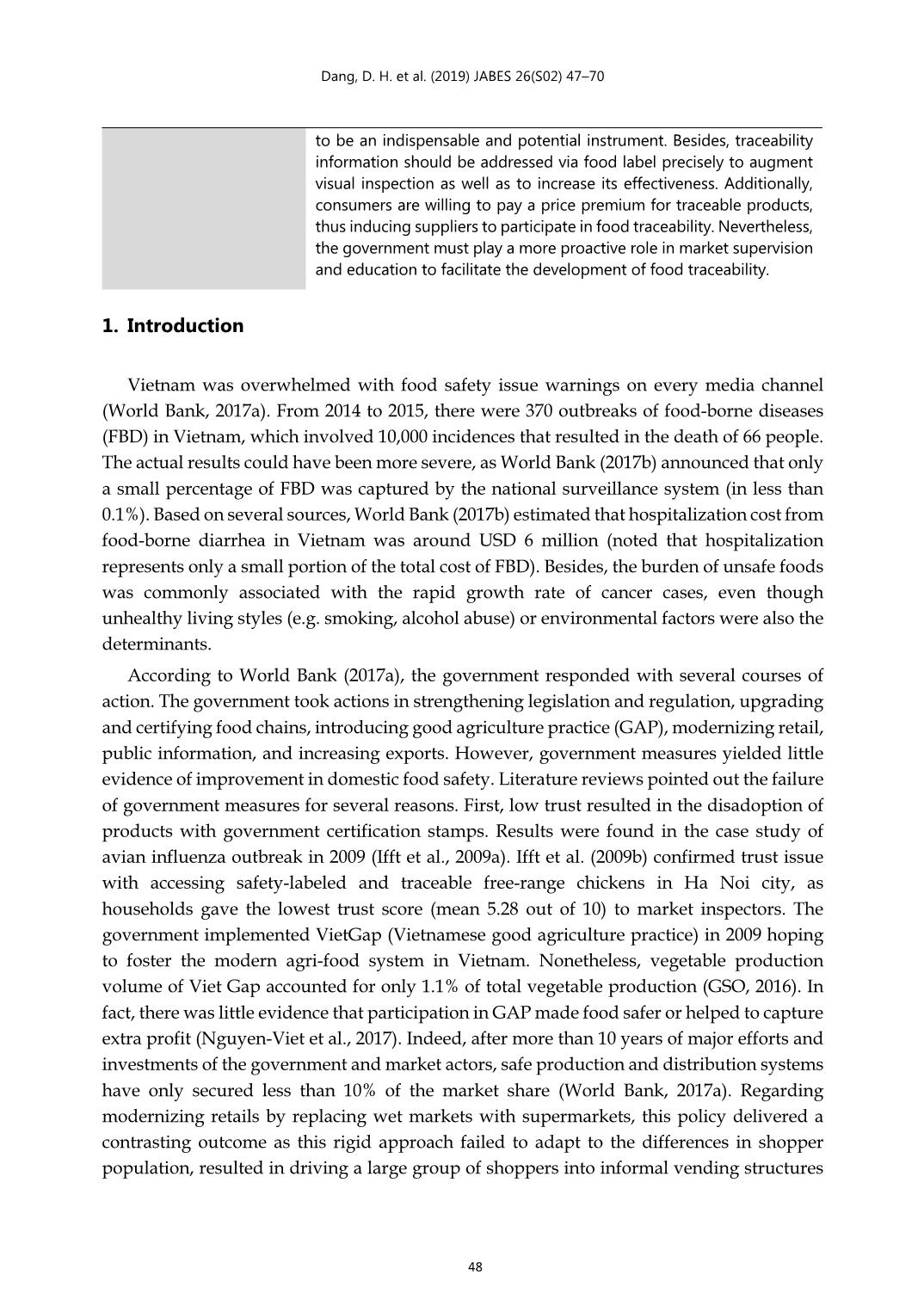
Trang 2
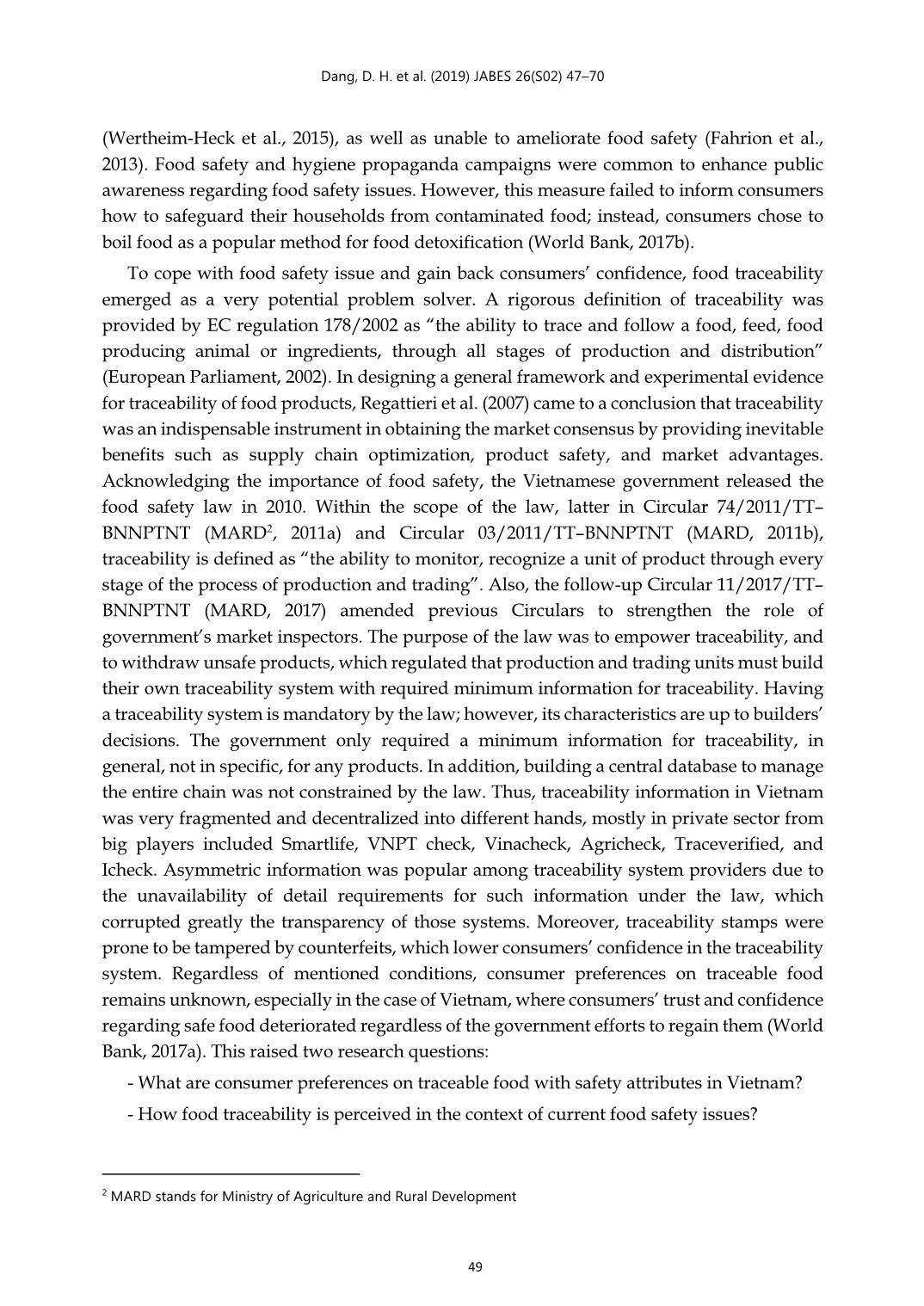
Trang 3

Trang 4
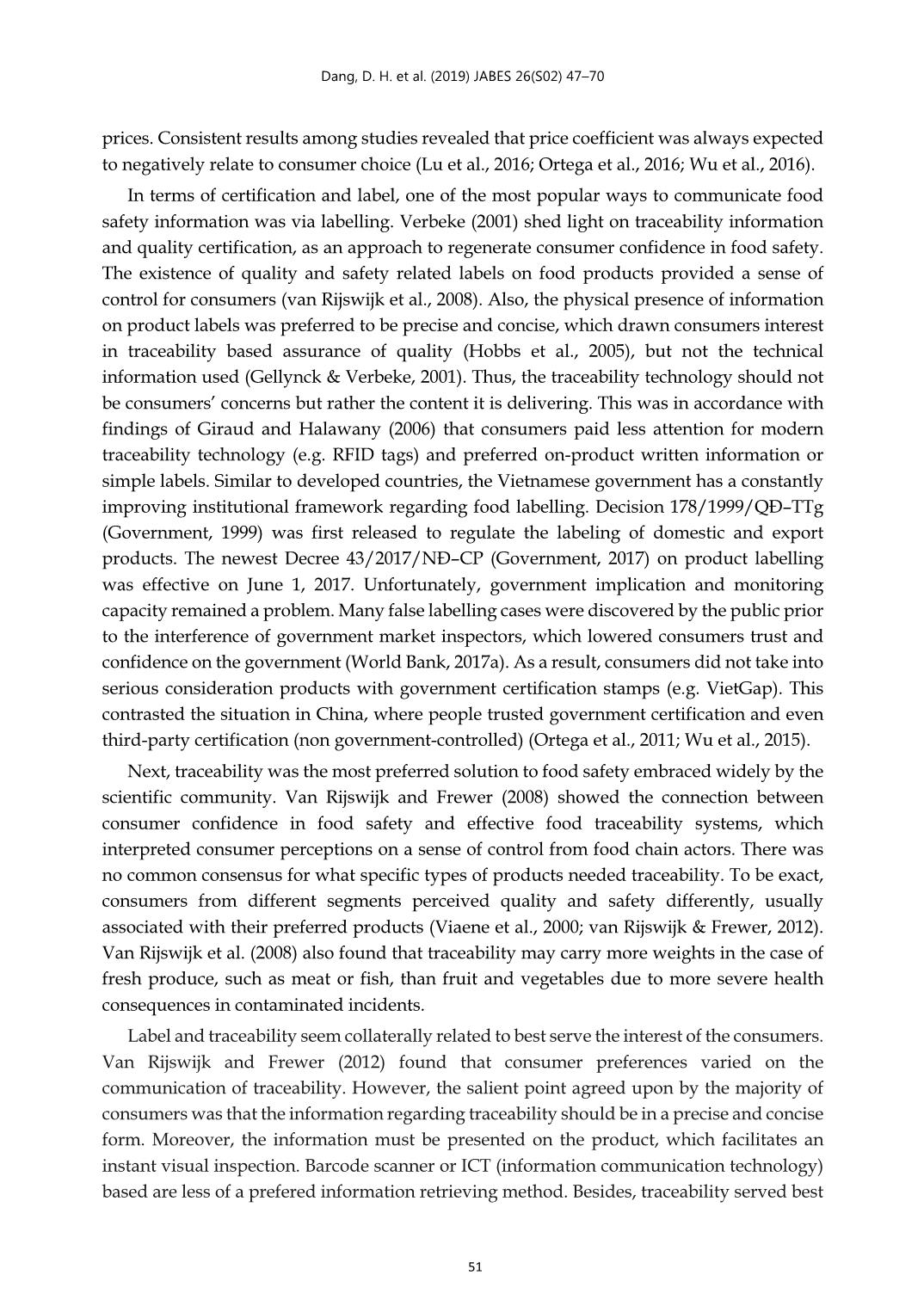
Trang 5
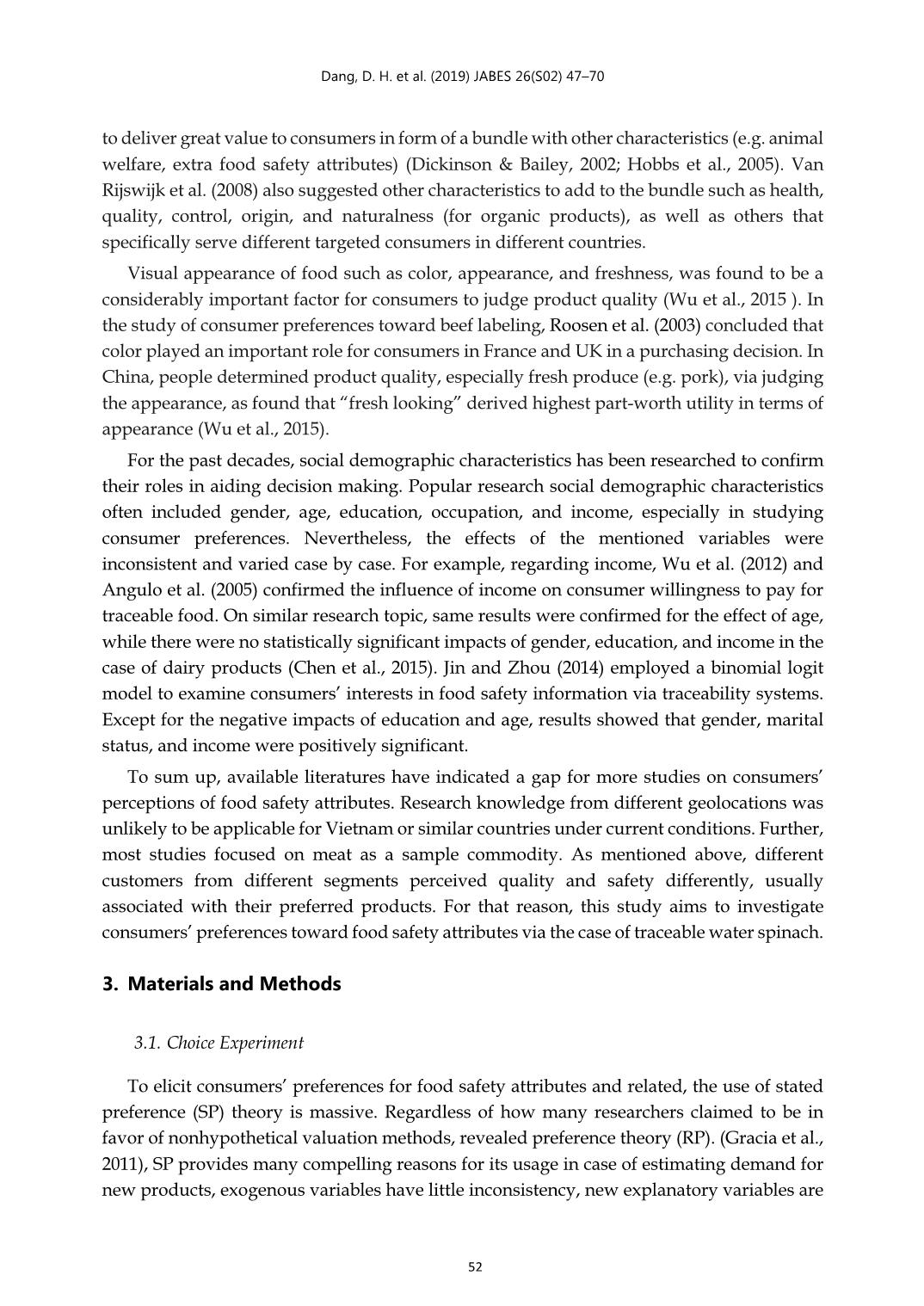
Trang 6
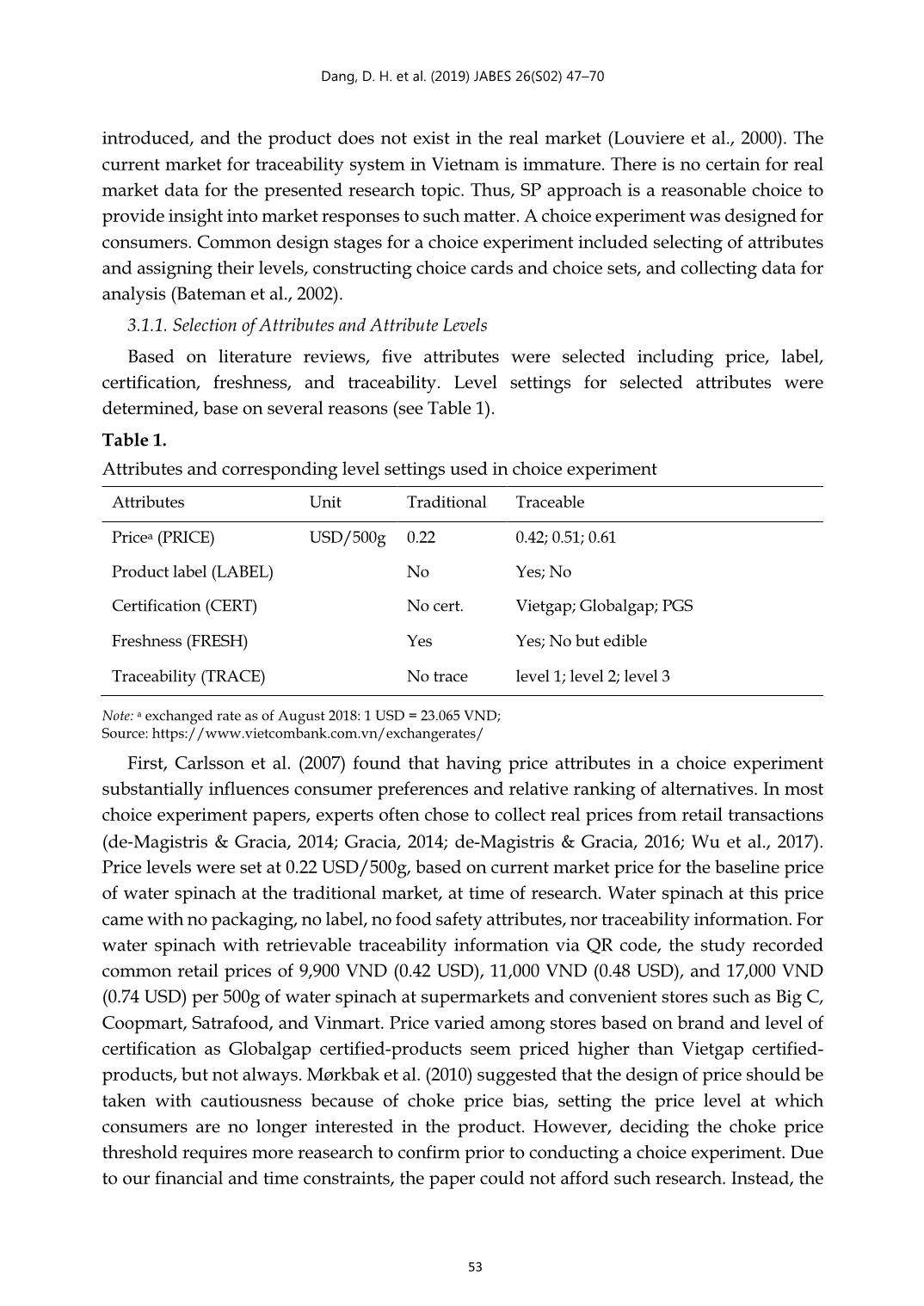
Trang 7

Trang 8
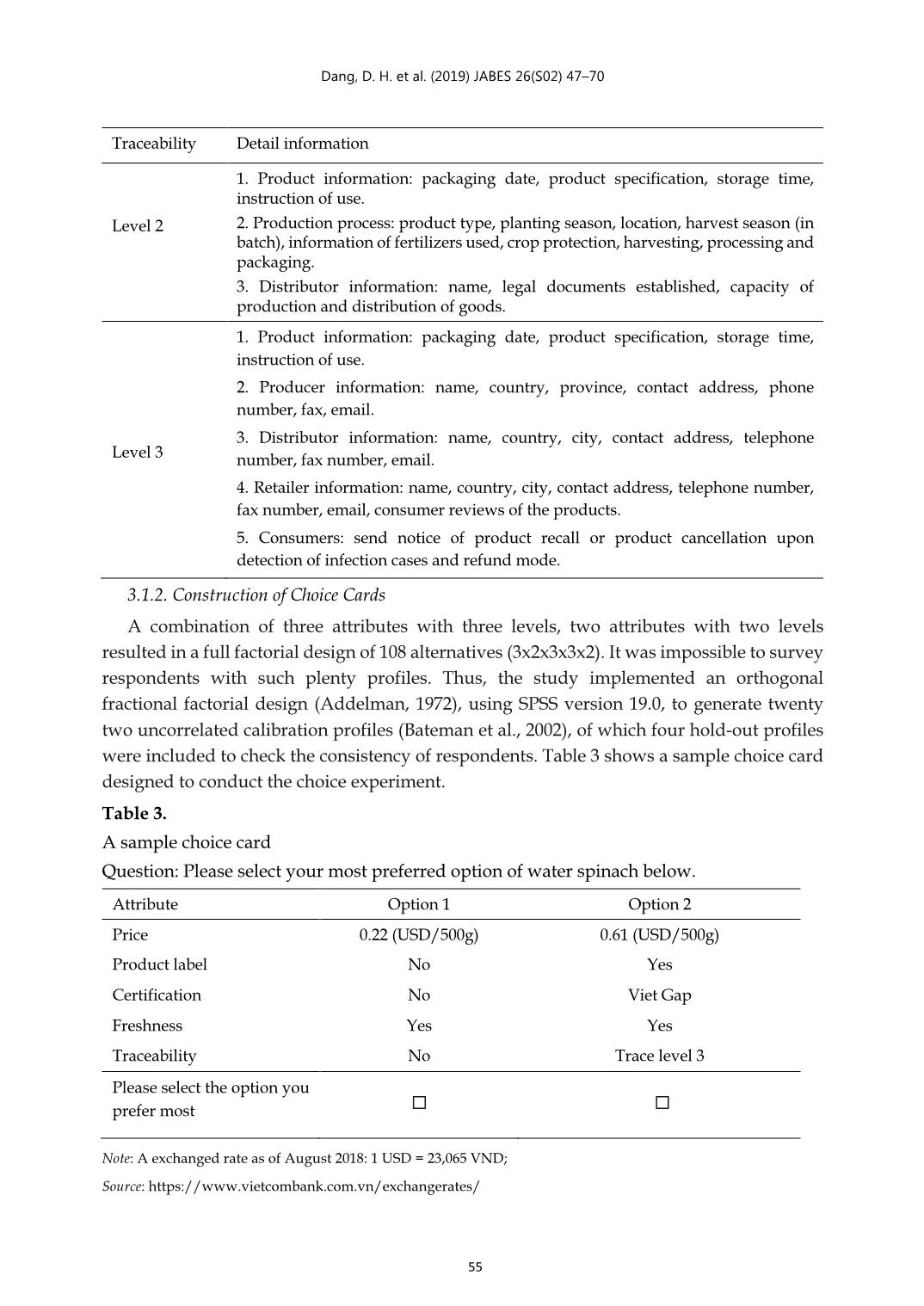
Trang 9
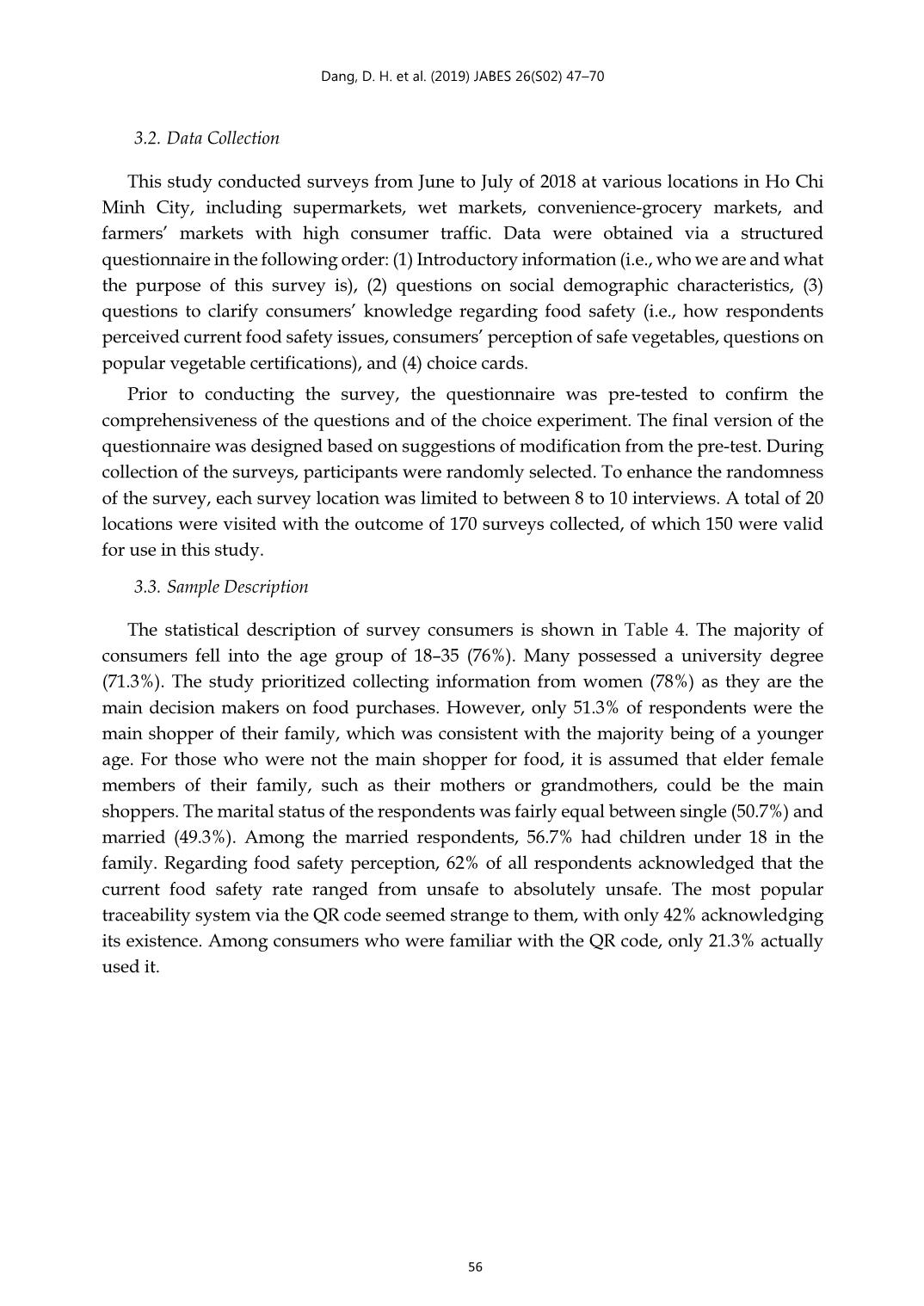
Trang 10
Tải về để xem bản đầy đủ
Tóm tắt nội dung tài liệu: Vietnamese consumers’ preferences for traceable food and safety attributes: The case of water spinach
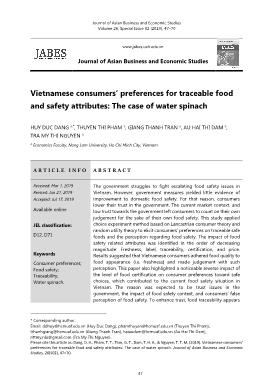
Journal of Asian Business and Economic Studies Volume 26, Special Issue 02 (2019), 47–70 47 www.jabes.ueh.edu.vn Journal of Asian Business and Economic Studies Vietnamese consumers’ preferences for traceable food and safety attributes: The case of water spinach HUY DUC DANG a,*, THUYEN THI PHAM a, GIANG THANH TRAN a, AU HAI THI DAM a, TRA MY THI NGUYEN a a Economics Faculty, Nong Lam University, Ho Chi Minh City, Vietnam A R T I C L E I N F O A B S T R A C T Received: Mar 1, 2019 Revised: Jun 21, 2019 Accepted: Jul 17, 2019 Available online JEL classification: D12, D71 Keywords Consumer preferences; Food safety; Traceability; Water spinach. The government struggles to fight escalating food safety issues in Vietnam. However, government measures yielded little evidence of improvement to domestic food safety. For that reason, consumers lower their trust in the government. The current market context, and low trust towards the government left consumers to count on their own judgement for the sake of their own food safety. This study applied choice experiment method based on Lancastrian consumer theory and random utility theory to elicit consumers’ preferences on traceable safe foods and the perception regarding food safety. The impact of food safety related attributes was identified in the order of decreasing magnitude: Freshness, label, traceability, certification, and price. Results suggested that Vietnamese consumers adhered food quality to food appearance (i.e. freshness) and made judgement with such perception. This paper also highlighted a noticeable reverse impact of the level of food certification on consumer preferences toward safe choices, which contributed to the current food safety situation in Vietnam. The reason was expected to be trust issues in the government, the impact of food safety context, and consumers’ false perception of food safety. To enhance trust, food traceability appears * Corresponding author. Email: ddhuy@hcmuaf.edu.vn (Huy Duc Dang), phamthuyen@hcmuaf.edu.vn (Thuyen Thi Pham), tthanhgiang@hcmuaf.edu.vn (Giang Thanh Tran), haiaudam@hcmuaf.edu.vn (Au Hai Thi Dam), nttmy.nlu@gmail.com (Tra My Thi Nguyen). Please cite this article as: Dang, D. H., Pham, T. T., Tran, G. T., Dam, T. H. A., & Nguyen, T. T. M. (2019). Vietnamese consumers’ preferences for traceable food and safety attributes: The case of water spinach. Journal of Asian Business and Economic Studies, 26(S02), 47–70. Dang, D. H. et al. (2019) JABES 26(S02) 47–70 48 to be an indispensable and potential instrument. Besides, traceability information should be addressed via food label precisely to augment visual inspection as well as to increase its effectiveness. Additionally, consumers are willing to pay a price premium for traceable products, thus inducing suppliers to participate in food traceability. Nevertheless, the government must play a more proactive role in market supervision and education to facilitate the development of food traceability. 1. Introduction Vietnam was overwhelmed with food safety issue warnings on every media channel (World Bank, 2017a). From 2014 to 2015, there were 370 outbreaks of food-borne diseases (FBD) in Vietnam, which involved 10,000 incidences that resulted in the death of 66 people. The actual results could have been more severe, as World Bank (2017b) announced that only a small percentage of FBD was captured by the national surveillance system (in less than 0.1%). Based on several sources, World Bank (2017b) estimated that hospitalization cost from food-borne diarrhea in Vietnam was around USD 6 million (noted that hospitalization represents only a small portion of the total cost of FBD). Besides, the burden of unsafe foods was commonly associated with the rapid growth rate of cancer cases, even though unhealthy living styles (e.g. smoking, alcohol abuse) or environmental factors were also the determinants. According to World Bank (2017a), the government responded with several courses of action. The government took actions in strengthening legislation and regulation, upgrading and certifying food chains, introducing good agriculture practice (GAP), modernizing retail, public information, and increasing exports. However, government measures yielded little evidence of improvement in domestic food safety. Literature reviews pointed out the failure of government measures for several reasons. First, low trust resulted in the disadoption of products with government certification stamps. Results were found in the case study of avian influenza outbreak in 2009 (Ifft et al., 2009a). Ifft et al. (2009b) confirmed trust issue with accessing safety-labeled and traceable free-range chickens in Ha Noi city, as households gave the lowest trust score (mean 5.28 out of 10) to market inspectors. The government implemented VietGap (Vietnamese good agriculture practice) in 2009 hoping to foster the modern agri-food system in Vietnam. Nonetheless, vegetable production volume of Viet Gap accounted for only 1.1% of total vegetable production (GSO, 2016). In fact, there was little evidence that participation in GAP made food safer or helped to capture extra profit (Nguyen-Viet et al., 2017). Indeed, after more than 10 years of major efforts and investments of the government and market actors, safe production and distribution systems have only secured less than 10% of the market share (World Bank, 2017a). Regarding modernizing retails by replacing wet markets with supermarkets, this policy delivered a contrasting outcome as this rigid approach failed to adapt to the differences in shopper population, resulted in driving a large group of shoppers into informal vending structures Dang, D. H. et al. (2019) JABES 26(S02) 47–70 49 (Wertheim-Heck et al., 2015), as well as unable to ameliorate food safety (Fahrion et al. ... e, the government should employ a comprehensive policy instruments to facilitate the transfer of modern post-harvest technology from research institutes and universities to help producers of traceable food to maintain a high level of freshness for their produces. Moreover, the government should play a significant role in cultivating markets for traceable food in order to gradually increase the exposure of traceable foods to the community. Changing consumers’ purchasing habit is a long-term plan that requires substantial endeavors with different approaches to ensure the result. Limitation There are three notable limitations in this study. First, the study only investigated the impact of factors based on variable levels. Further investigation on the impact of different attribute levels would elicit more useful details as not all attribute levels would be statistically significant and contribute to the knowledge of consumers’ preferences as a whole (see examples: Ortega et al., 2016; Wu et al., 2012). Second, the study was conducted on citizens of Ho Chi Minh city, which was hard to be representative of Vietnamese population. Thus, future studies should consider a more representative sample of Vietnam. Third, our sample commodity used in this study was water spinach, intended to use instead of meat to study consumer preferences for fresh produces. Van Rijswijk and Frewer (2012) suggested that consumer preferences may vary for different products. For that reason, further studies with different sample commodities may give more insights into consumers’ preferences. Acknowledgements All consumers, supervisors, and managers of the supermarkets and convenient stores who participated and facilitated the survey are gratefully acknowledged. We are also grateful for insightful comments of two anonymous reviewers. We also would like to express special thanks to Mr. John Maceda for proofreading and editing language for the paper. Funding: This research did not receive any specific grant from funding agencies in the public, commercial, or not-for-profit sectors.n Dang, D. H. et al. (2019) JABES 26(S02) 47–70 66 References Addelman, S. (1972). Recent developments in the design of factorial experiments. Journal of the American Statistical Association, 67(337), 103–111. Angulo, A. M., Gil, J. M., & Tamburo, L. (2005). Food safety and consumers' willingness to pay for labelled beef in Spain. Journal of Food Products Marketing, 11(3), 89–105. Bateman, I. J., Carson, R. T., Day, B., Hanemann, M., Hanleys, N., Hett, T., Jones-Lee, M., Loomes, G., Mourato, S., Ozdemiroglu, E., Pearce, D. W., Sugden, R. & Swanson, J. (2002). Economic Valuation with Stated Preference Techniques: A Manual. Cheltenham, UK: Edward Elgar Publishing. Carlsson, F., Frykblom, P., & Lagerkvist, C. J. (2007). Preferences with and without prices - Does the price attribute affect behavior in stated preference surveys?. Environmental and Resource Economics, 38(2), 155–164. Chen, T., Chen, M., & Kiyohide, M. (2015). Impact of food safety incident on consumers' willingness to pay: The case of China. Journal of Integrated Field Science, 12, 53–58. Christensen, B. J., Bailey, D., Hunnicutt, L., & Ward, R. A. (2003). Consumer preferences for public and private sector certifications of beef products in the United States and the United Kingdom. International Food and Agribusiness Management Review, 6(3), 19–39. de-Magistris, T., & Gracia, A. (2016). Consumers' willingness-to-pay for sustainable food products: The case of organically and locally grown almonds in Spain. Journal of Cleaner Production, 118, 97–104. de-Magistris, T., & Gracia, A. (2014). Do consumers care about organic and distance labels? An empirical analysis in Spain. International Journal of Consumer Studies, 38(6), 660–669. Dickinson, D. L., & Bailey, D. (2002). Meat traceability: Are US consumers willing to pay for it?. Journal of Agricultural and Resource Economics, 27(2), 348–364. European Parliament. (2002). Regulation (EC) No. 178/2002 of the European Parliament and of the Council. Official Journal of the European Communities, L31/1–L31/24. Fahrion, A. S., Lapar, M. L., Nguyen, N.T., Do, N. T., & Grace, D. (2013). Food-borne hazards in a transforming pork value chain in Hanoi: Basis for future risk assessments. Vietnamese Journal of Preventive Medicine, 23(4), 18–25. Gellynck, X., & Verbeke, W. (2001). Consumer perception of traceability in the meat chain. Agrarwirtschaft, 50(6), 368–373. Giraud, G., & Halawany, R. (2006). Consumers' perception of food traceability in Europe. In Proceedings of the 98th EAAE Seminar: Marketing Dynamics within the Global Trading System (pp.1–9). Chania, Greece: EAAE. Golan, E. H., Krissoff, B., Kuchler, F., Calvin, L., Nelson, K., & Price, G. (2004). Traceability in the US food supply: Economic theory and industry studies. Agricultural Economic Report Number 830. Retrieved from: https://ageconsearch.umn.edu/record/33939/ Dang, D. H. et al. (2019) JABES 26(S02) 47–70 67 Government. (1999). Decision No. 178/1999/QD-TTg dated Aug 30, 1999 promulgating the regulation on the labeling of goods to be circulated in the country and export as well as import goods. Retrieved from: https://thuvienphapluat.vn/van-ban/Thuong-mai/178-1999- QD-TTg-78979.aspx Government. (2017). Decree 43/2017/ND-CP dated Apr 14, 2017 on good labels. Retrieved from: https://thuvienphapluat.vn/van-ban/Thuong-mai/Decree-43-2017-ND-CP-on-good- labels-348247.aspx Gracia, A. (2014). Consumers’ preferences for a local food product: A real choice experiment. Empirical Economics, 47(1), 111–128. Gracia, A., Loureiro, M. L., & Nayga, J. R. M. (2011). Are valuations from nonhypothetical choice experiments different from those of experimental auctions?. American Journal of Agricultural Economics, 93(5), 1358–1373. GSO. (2016). Kết quả tổng điều tra Nông thôn, Nông nghiệp và Thủy sản năm 2016. Retrieved from: https://www.gso.gov.vn/default_en.aspx?tabid=515&idmid=5&ItemID=18966 Hobbs, J. E., Bailey, D., Dickinson, D. L., & Haghiri, M. (2005). Traceability in the Canadian red meat sector: do consumers care? Canadian Journal of Agricultural Economics/Revue Canadienne D'agroeconomie, 53(1), 47–65. Ifft, J., Otte, J., Roland-Holst, D., & Zilberman, D. (2009a). Poultry certification for pro-poor HPAI risk reduction. Mekong Team Working Paper No. 6, Pro-poor HPAI risk reduction project. Retrieved from https://www.academia.edu/1019770/Poultry_Certification_for_Pro- Poor_HPAI_Risk_Reduction Ifft, J., Roland-Holst, D., & Zilberman, D. (2009b). Valuation of safety-branded and traceable free range chicken in Ha Noi: Results from a field experiment. In Proceedings of the Agricultural & Applied Economics Association 2009 AAEA & ACCI Joint Annual Meeting. Milwaukee, Wisconsin, USA. Jin, S., Zhang, Y., & Xu, Y. (2017). Amount of information and the willingness of consumers to pay for food traceability in China. Food Control, 77, 163–170. Jin, S., & Zhou, L. (2014). Consumer interest in information provided by food traceability systems in Japan. Food Quality and Preference, 36, 144–152. Đỗ Kim Chung, & Nguyễn Linh Trung. (2015). Sự lựa chọn của người mua rau tại chợ và siêu thị trên địa bàn thành phố Hà Nội. Tạp chí Khoa học và Phát triển, 13(2), 308–315. Lancaster, K. J. (1966). A new approach to consumer theory. Journal of Political Economy, 74(2), 132–157. Liao, P.-A., Chang, H.-H., & Chang, C.-Y. (2011). Why is the food traceability system unsuccessful in Taiwan? Empirical evidence from a national survey of fruit and vegetable farmers. Food Policy, 36(5), 686–693. Dang, D. H. et al. (2019) JABES 26(S02) 47–70 68 Loureiro, M. L., & Umberger, W. J. (2007). A choice experiment model for beef: What US consumer responses tell us about relative preferences for food safety, country-of-origin labeling and traceability. Food Policy, 32(4), 496–514. Louviere, J. J., Hensher, D. A., & Swait, J. D. (2000). Stated Choice Methods: Analysis and Applications. Cambridge: Cambridge University Press. Lu, J., Wu, L., Wang, S., & Xu, L. (2016). Consumer preference and demand for traceable food attributes. British Food Journal, 118(9), 2140–2156. Luce, R. D. (1959). Individual Choice Behavior: A Theoretical Analysis. New York: Wiley. MARD. (2011a). Circular 74/2011/TT–BNNPTNT dated Oct 31, 2011 on traceability, recall and handling of unsafe agricultural and forest food. Retrieved from: https://thuvienphapluat.vn/van-ban/the-thao-y-te/Circular-No-74-2011-TT- BNNPTNT-on-traceability-recall-and-handling-of-unsafe-133422.aspx MARD. (2011b). Circular 03/2011/TT–BNNPTNT dated Jan 21, 2011 on tracing and recall of fishery products failing to meet food quality and safety requirements. Retrieved from: https://thuvienphapluat.vn/van-ban/Linh-vuc-khac/Circular-No-03-2011-TT- BNNPTNT-on-tracing-and-recall-of-fishery-products-faili-122850.aspx MARD. (2017). Circular No. 11/2017/TT-BNNPTNT dated May 29, 2017 on amendments to some articles of legislative documents relating to functions and tasks of units affiliated to the Ministry of Agriculture and Rural Development. Retrieved from: https://thuvienphapluat.vn/van- ban/bo-may-hanh-chinh/circular-11-2017-tt-bnnptnt-amendments-documents- relating-functions-and-tasks-of-units-affiliated-368989.aspx McFadden, D.(1973). Conditional logit analysis of qualitative choice behavior. In P. Zarembka (Ed.), Frontiers of Econometrics (pp. 105–142). New York: Academic Press. Mørkbak, M. R., Christensen, T., & Gyrd-Hansen, D. (2010). Choke price bias in choice experiments. Environmental and Resource Economics, 45(4), 537–551. Ngoc, P. T. A., Meuwissen, M. P. M., Le, T. C., Bosma, R. H., Verreth, J., & Lansink, A. O. (2016). Adoption of recirculating aquaculture systems in large pangasius farms: A choice experiment. Aquaculture, 460, 90–97. Nguyen-Viet, H., Tuyet-Hanh, T. T., Unger, F., Dang-Xuan, S., & Grace, D. (2017). Food safety in Vietnam: Where we are at and what we can learn from international experiences. Infectious Diseases of Poverty, 6, 39. Ortega, D. L., Hong, S. J., Wang, H. H., & Wu, L. (2016). Emerging markets for imported beef in China: Results from a consumer choice experiment in Beijing. Meat Science, 121, 317–323. Ortega, D. L., Wang, H. H., Wu, L., & Olynk, N. J. (2011). Modeling heterogeneity in consumer preferences for select food safety attributes in China. Food Policy, 36(2), 318–324. Regattieri, A., Gamberi, M., & Manzini, R. (2007). Traceability of food products: General framework and experimental evidence. Journal of Food Engineering, 81(2), 347–356. Dang, D. H. et al. (2019) JABES 26(S02) 47–70 69 Röhr, A., Lüddecke, K., Drusch, S., Müller, M. J., & Alvensleben, R. v. (2005). Food quality and safety––consumer perception and public health concern. Food Control, 16(8), 649–655. Roosen, J., Lusk, J. L., & Fox, J. A. (2003). Consumer demand for and attitudes toward alternative beef labeling strategies in France, Germany, and the UK. Agribusiness: An International Journal, 19(1), 77–90. van Rijswijk, W., & Frewer, L. J. (2008). Consumer perceptions of food quality and safety and their relation to traceability. British Food Journal, 110(10), 1034–1046. van Rijswijk, W., & Frewer, L. J. (2012). Consumer needs and requirements for food and ingredient traceability information. International Journal of Consumer Studies, 36(3), 282–290. van Rijswijk, W., Frewer, L. J., Menozzi, D., & Faioli, G. (2008). Consumer perceptions of traceability: A cross-national comparison of the associated benefits. Food Quality and Preference, 19(5), 452–464. Verbeke, W. (2001). The emerging role of traceability and information in demand-oriented livestock production. Outlook on Agriculture, 30(4), 249–255. Verbeke, W., & Ward, R. W. (2006). Consumer interest in information cues denoting quality, traceability and origin: An application of ordered probit models to beef labels. Food Quality and Preference, 17(6), 453–467. Viaene, J., Verbeke, W., & Gellynck, X. (2000). Quality perception of vegetables by Belgian consumers. Acta Horticulturae, 524, 89–96. Wertheim-Heck, S. C., Vellema, S., & Spaargaren, G. (2015). Food safety and urban food markets in Vietnam: The need for flexible and customized retail modernization policies. Food Policy, 54, 95–106. World Bank. (2017a). Vietnam Food Safety Risks Management: Challenges and Opportunities: Technical working paper (English). Retrieved from: working-paper World Bank. (2017b). Vietnam Food Safety Risks Management: Challenges and Opportunities (Vol. 2): Annexes (English). Retrieved from: Wu, L., Gong, X., Qin, S., Chen, X., Zhu, D., Hu, W., & Li, Q. (2017). Consumer preferences for pork attributes related to traceability, information certification, and origin labeling: Based on China's Jiangsu Province. Agribusiness, 33(3), 424–442. Wu, L., Wang, H., Zhu, D., Hu, W., & Wang, S. (2016). Chinese consumers’ willingness to pay for pork traceability information—the case of Wuxi. Agricultural Economics, 47(1), 71–79. Wu, L., Wang, S., Zhu, D., Hu, W., & Wang, H. (2015). Chinese consumers’ preferences and willingness to pay for traceable food quality and safety attributes: The case of pork. China Economic Review, 35, 121–136. Dang, D. H. et al. (2019) JABES 26(S02) 47–70 70 Wu, L., Xu, L., & Gao, J. (2011). The acceptability of certified traceable food among Chinese consumers. British Food Journal, 113(4), 519–534. Wu, L., Xu, L., Zhu, D., & Wang, X. (2012). Factors affecting consumer willingness to pay for certified traceable food in Jiangsu Province of China. Canadian Journal of Agricultural Economics/Revue Canadienne D'agroeconomie, 60(3), 317–333.
File đính kèm:
 vietnamese_consumers_preferences_for_traceable_food_and_safe.pdf
vietnamese_consumers_preferences_for_traceable_food_and_safe.pdf

